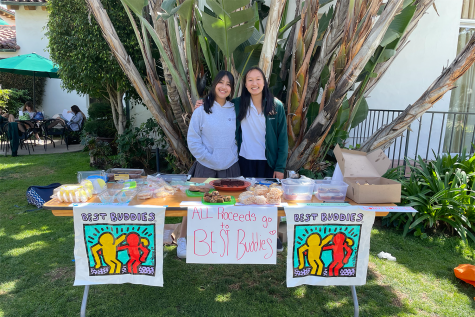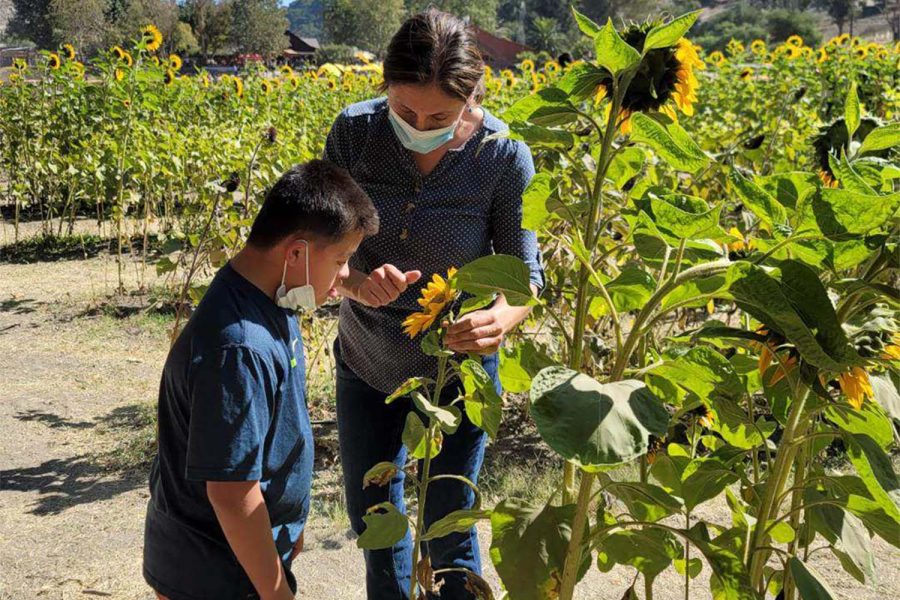‘Another dimension of diversity’: Special-Education students engage in school communities
April 24, 2022
Photo credit: Maia Alvarez
Fourth grader Daniel Cortez, who has Down syndrome, learning about a sunflower from his mother, Marisol Cortez, at Avila Farm during quarantine. Vanderbilt said through exposure and intentional education, different kinds of diversity can be explored. “Neurodiversity is just one of the dimensions of diversity, that we can experience,” Vanderbilt said. “It’s another diversity element that people should be thinking about — and how do we learn more about that in addition to ethnicity and culture and gender and sexual orientation.”
A young girl with autism painting in her art class. A young boy with Down syndrome completing a math problem. A school where both children have the right to learn.
In the United States, nearly 7 million students were enrolled in special education programs at public schools in the 2019-2020 school year, totaling 14% of national enrollment.
What is the IEP system?
Individuals with Disabilities Education Act (IDEA) is a federal law specifying that children with disabilities have the right to free and appropriate public education and services. The IDEA law uses the Individualized Education Program (IEP), a written education plan designed to the needs and accommodations of the child. The Los Angeles Unified School District offers the IEP to any disabled child with any of 13 specified disabilities, including autism, intellectual disability and Down syndrome.
The process commences with parents making a written request to the school district expressing their concerns about their child’s learning. Once the request is made, the school will plan for an assessment to determine the child’s eligibility for the services. With parental consent, a multidisciplinary team of at least one teacher and a specialist assess the child in all areas related to their suspected disability. Lastly, an IEP meeting is held to discuss the assessment results and whether the child is eligible for special education services.
I’m the guard. I’m the protector. I am my child’s voice for their rights, their equality, for their humanity
— Stacy Overland, parent of two special education students with autism
According to Developmental-Behavioral Pediatrician Sai N. Iyer from UCLA, the IEP process can use a Response to Intervention (RTI) model to provide evidence-based intervention to a child who’s fallen behind in a particular academic subject, without waiting for a full evaluation to determine whether they have a learning disability. While the intervention is meant to take place every six weeks, the RTI can take up to a year depending on the school’s administration. Additionally, once the parents are given back the diagnosis, parents aren’t typically given follow-up information on how to provide for their child’s newfound disability.
Stacy Overland, a parent of two special education students with autism, said the lack of clarity and support the school district gave during her son Storm’s IEP meeting left her feeling stranded.
“We had a meeting and then they go, ‘Your child has autism.’ And that’s it. Well, what is autism? What do you mean? Are they going to die from it?” Overland said. “And that’s how they leave you. Then you have to fend for yourself, sink or swim.”
As the parents administer the entire system of teachers, services and accommodations for their children, Iyer said supporting them is significant. She said her job is not only to evaluate children to give diagnoses, but also to empower parents to advocate for their children’s rights.
“The IEP process starts with parents … giving a letter in writing. A lot of times parents are not aware of this. They feel powerless,” Iyer said. “[Parents say], ‘The teacher said he’s a little bit behind, but it’s not behind enough that we need to do something about it’ — We don’t want to wait until he’s behind enough, right? We want to do something about it right now.”

It Takes a Village
One of the IDEA’s defining principles emphasizes that students are meant to learn in the least restrictive environment, the most appropriate learning environment for the child.
“You want that ideal mix for every child regardless of whether they have a disability or not. So the IEP process, it tries to do that — it tries to fit the child in the environment that’s right for that particular child,” Iyer said. “It’s not one size fits all. It has to really be an individualized education program.”
For some students, the least restrictive environment is the general education classroom. According to the U.S. Department of Education’s National Center for Education Statistics, 61.8% of special education students spend more than 80% of their academic time in general education classrooms. However, other students learn best in the special day class. The special day class is for students whose nature or severity of their disability requires focused teaching from a special education teacher without any general education students in the learning environment. Nonetheless, students in the special day class can return to the general education class over time.
“There’s always ways out. You just never stay in one place. It’s just about you put[ting] in the work,” Jessy Barahona Dubon, a special education assistant at Mark Twain Middle School, said. “You put in the work, you achieve. You do great and then you will move into a better, more faster-paced class.”
Outside of academics, engagement can take place in elective activities. Maria Ventura, a special education teacher at Grandview Boulevard Elementary School, said she works alongside general education third grade teacher Angelita Leyva to provide opportunities for both of their students to practice soft skills.
“We did art together. We did music together. We would do activities and we would have our class parties,” Ventura said. “I know some people think, ‘Oh my gosh, it’s a waste of time.’ But for my kids, a lot of times they don’t get an opportunity to be part of a class party or to go to a party and meet with their peers.”
Non-profit organizations, including Club 21, Autism Speaks and Best Buddies have been founded not only to make up for the connection lost in school but to empower children with intellectual and developmental disabilities (IDD). Alyssa Ponratana, chapter president of Best Buddies at Archer, said that togetherness through extracurricular activities promotes inclusion and joy.
“One noteworthy aspect of Best Buddies is the one-to-one friendship idea, [that’s] all you need to not feel alone,” Ponrartana said. “But then at the same time, the chapter brings all the pairs together so that everyone is mixing and having fun together.”
Iyer said understanding and empathy grow when non-IDD individuals expose themselves to the differences special education students experience.
“I’ve seen where they have baseball games right for kids with special needs,” Iyer said. “[Children without disabilities] get to see, ‘Wow, the things that I take for granted. I never thought anything about running to first base but wow, if you’re in a wheelchair, I see how hard that can be for you.’”
![Fourth grader Snow Overland painting during her art class. Through the support of her system of services and a school community striving to help her grow in the least restrictive area, special education students like Snow can learn. "I think [of] children who have special needs, like my daughter Snow," Overland said. "She loves people for who they are. She doesn't look at you like how you're dressed. Or if you talk funny, or if you're a person of color or you know, she doesn't care about any of that stuff. She just likes and loves you for who you are. And I think that's really special. Because I think a lot of us may never get that."](https://archeroracle.org/wp-content/uploads/2022/03/Resized_IMG_5718-356x475.jpeg)
Impact of COVID-19
In the 2018-2019 school year, LAUSD enrolled 72,346 special education students. Yet, when schools began the year online through Zoom, only 65,555 special education students enrolled for the 2020-2021 school year.
“When think[ing] about a child who may need real individualized learning, a small group learning, that’s not going to work on Zoom,” Dr. Douglas Vanderbilt said, division head of developmental-behavioral pediatrics at Children’s Hospital of Los Angeles. “These kids who have really needed intensive face-to-face interactions to learn … Families weren’t comfortable with new people coming into the home. They didn’t feel comfortable sending their kids to school. Teachers weren’t there even if you did want to send them to school. They just missed out on massive amounts of specific interventions.”
In the shift to remote learning, students with special needs have regressed from the progress they were making academically and socially with their teachers and services. Despite the psychological impact the pandemic had on families and teachers of special education students, a greater understanding between teachers and parents developed behind the screens.
“It really built rapport within parents, family, teachers and staff. They really saw how hard we work and what we [do]” Ventura said. “They realize that the learning process doesn’t stop once they leave school. It should continue at home so that everyone’s on the same page so that it helps the student further learn and advance in their education.”
Parent Stacy Overland describes her wish to have a greater support system for the entire family of a special education child.
Future of Special-Education
Ventura said that a greater connection between state testing and communal engagement if a middle ground can be made.
“[I wish for] every teacher getting involved and seeing the value of integration and working with different kids … That there’s more events [and] activities that allow for interaction amongst kids with special needs and neurotypical kids,” Ventura said. “A by-in collaboration [that’s] initiating more empathy instead of apathy.”
As both general and special education students return to in-person learning, Vanderbilt said past educational systems can be improved upon to promote connection in the classroom.
“Let’s not just try to get back to the way it was,” Vanderbilt said. “Let’s think about inclusion. Let’s think about neurodiversity. Let’s think about doing things in ways that bring kids together so that they can learn from each other in a holistic learning environment.”



Maya Wernick • Apr 25, 2022 at 8:33 am
Hi Maia!
What a great article overviewing the US system of special education. This was a great summary and provided plenty of detail in an accessible way! As an upcoming special education teacher myself, I am constantly thinking about systems of support for students with disabilities—how can parents, teachers, school administrators, policymakers, the school community, and most importantly, students themselves, best work together to foster an inclusive learning environment for everyone? Great work, Maia!